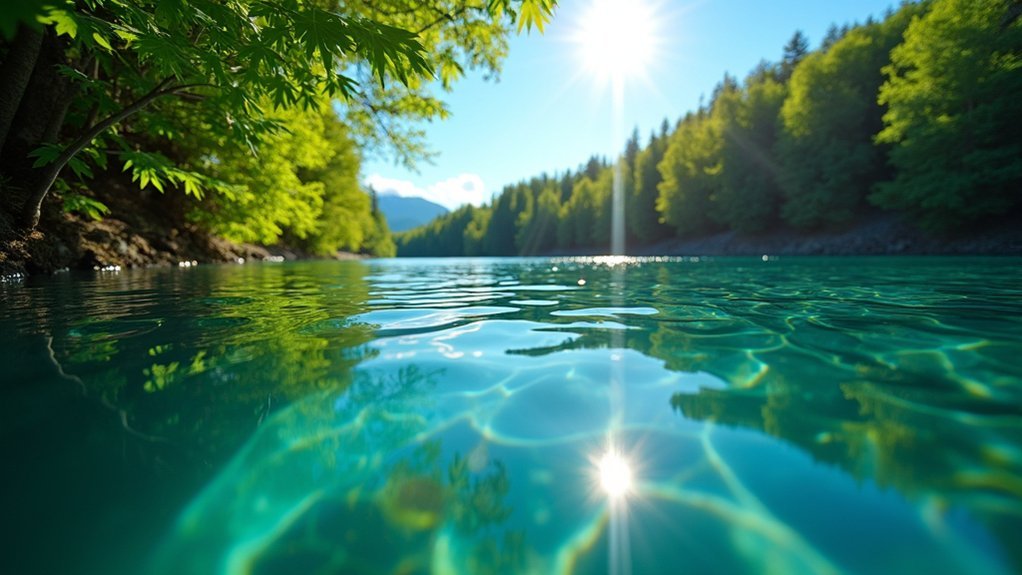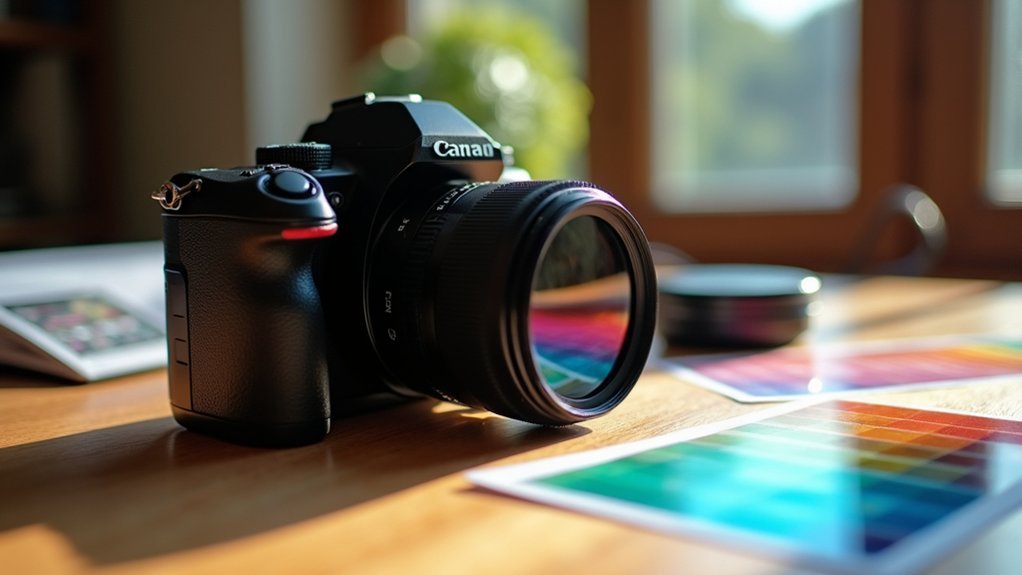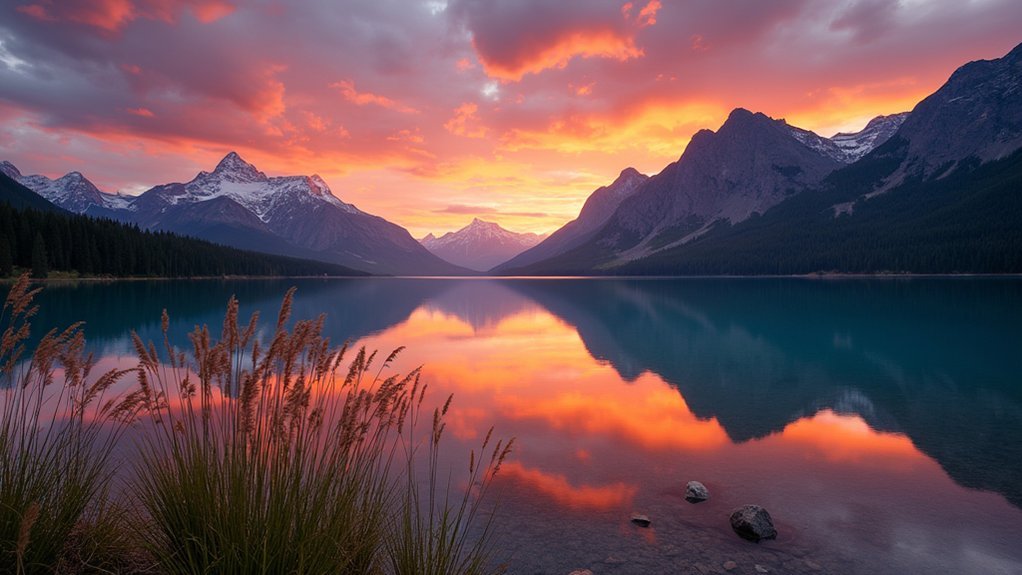To master exposure with polarized light, use manual mode and spot metering while compensating for the 2-4 stop light loss from polarizing filters. Mount your camera on a tripod, engage LiveView for precise focus, and bracket exposures between -2 and +2 stops. Position linear polarizers at 90° angles to light sources, and set up diffused lighting at 45° angles to your subject. Proper technique will reveal rich colors and surface details invisible to the naked eye.
Mastering Camera Exposure For Polarized Light Photography

When venturing into polarized light photography, you’ll need to adapt your standard exposure techniques to accommodate the unique challenges of this specialized approach. Polarizing filters can reduce light by up to four stops, requiring significant exposure adjustments to maintain proper image quality.
Start by orienting your circular polarizing filter 90 degrees opposite to your lighting setup’s filters to effectively eliminate glare.
The secret to glare-free polarized photography lies in positioning your filter exactly perpendicular to your light source’s polarization.
Switch to manual exposure mode and utilize the laws of reciprocity to calculate appropriate settings. You’ll often need longer shutter speeds, so secure your camera on a sturdy tripod to prevent camera shake.
Enable LiveView mode to compose and focus accurately through dark polarizing filters. Activate Long-Exposure Noise Reduction to minimize post-processing work later.
With these adjustments, you’ll capture beautifully exposed polarized images despite the technical challenges involved.
The Physics Behind Polarized Light
To fully master polarized light photography, you’ll need to understand the scientific principles at work. Light waves naturally vibrate in multiple directions, but when they reflect off surfaces, they become polarized—vibrating in a single plane and creating glare that diminishes image quality.
A polarizing filter selectively blocks light waves except those vibrating in one direction, effectively eliminating unwanted glare and enhancing color saturation in your photographs.
| Light Type | Vibration Pattern | Effect on Images |
|---|---|---|
| Unpolarized | Multiple directions | Less contrast, visible glare |
| Partially Polarized | Some organization | Moderate clarity |
| Fully Polarized | Single direction | Maximum detail, rich colors |
For best results, position your polarizing filter at a 90-degree angle to the light source—this maximizes its glare-reduction capabilities and reveals surface textures that would otherwise remain hidden.
Essential Equipment for Cross-Polarization

To achieve effective cross-polarization in your photography, you’ll need a linear polarizing filter for your camera and polarizing sheets placed at 45° angles in front of your light sources.
Select quality diffused lighting equipment with polarizing film oriented 90° opposite to your camera filter to eliminate unwanted reflections and glare.
Consider investing in mounting solutions like the Magfilter adapter if your camera lacks filter threads, ensuring your complete setup remains stable and adjustable throughout your art documentation sessions.
Polarizing Filters Setup
Setting up polarizing filters correctly makes all the difference between a mediocre photograph and a professional-quality capture of artwork. When arranging your polarizing filters, verify they’re compatible with your camera’s autofocus system by using linear polarizers, and confirm the polarizing film orientation in your light setup.
Position your lamps with polarizing filters at 45° angles to the artwork, level with the painting’s vertical center. This arrangement minimizes glare while maximizing surface detail visibility.
| Setup Element | Correct Position | Common Mistake |
|---|---|---|
| Light Source | 45° angle to artwork | Too direct or too oblique |
| Polarization Direction | Consistent across all sources | Mixed orientations |
| Filter Placement | Camera and all lights | Only on camera |
| Diffusers | Applied to all lamps | Forgotten or inconsistent |
Always use a tripod and manual focus, as the polarizing filters greatly darken the scene.
Light Sources Selection
The successful execution of cross-polarization photography hinges entirely on your choice of light sources. When selecting equipment, prioritize lamps that can accommodate polarizing filters while providing even illumination across your artwork. A prophoto pack with diffusers is ideal as it softens light and minimizes harsh reflections—critical for achieving clear results.
Position your light sources at 45° angles to the artwork to optimize the polarizing filters’ effectiveness, enhancing surface detail visibility while reducing glare.
Remember to align your filters correctly: orient the light source filters in one direction while positioning your camera’s filter at a right angle.
For professional results, surround your setup with black voile material to absorb unwanted reflections and maintain the integrity of your polarized light effect.
Mounting Equipment Essentials
Successful cross-polarization photography demands specific equipment properly mounted for ideal results.
You’ll need to carefully select and position your gear to eliminate glare while maintaining image quality.
- Linear polarizing filters are essential for your camera—avoid circular polarizing options as they can interfere with your auto-focus system’s functionality.
- Magfilter adapters provide the perfect solution for cameras lacking built-in filter threads, ensuring you can attach polarizers to virtually any lens.
- Polarizing film must be properly mounted on your light sources, maintaining consistent orientation across all lamps for effective glare elimination.
- Light positioning requires mounting lamps at precise 45° angles to your artwork’s vertical center, with diffusers attached to create soft, even illumination and minimize harsh shadows.
Camera Settings for Glare-Free Documentation

When working with polarizing filters, you’ll need to adjust your camera’s metering to account for the significant light reduction they cause.
Setting your camera to manual mode gives you complete control over exposure parameters, allowing you to fine-tune shutter speed, aperture, and ISO for ideal results despite filter-induced light loss.
Don’t hesitate to bracket your exposures by shooting multiple frames at different settings, ensuring you capture at least one perfectly exposed image of your artwork that balances detail preservation with accurate color reproduction.
Metering Through Filters
Mastering exposure while shooting through polarizing filters requires understanding how these accessories affect your camera’s light readings. When metering through filters, remember that polarizers can reduce light transmission by 1-4 stops, greatly impacting your exposure settings.
For best results when metering through filters:
- Use spot metering to evaluate exposure based on your subject’s brightness, helping counteract glare from surrounding surfaces.
- Focus your lens before attaching the polarizer, as the darker filter makes achieving accurate focus more challenging.
- Switch to manual mode for complete control over shutter speed, aperture, and ISO as polarizer effectiveness changes.
- Check and adjust your exposure settings frequently throughout your shoot as changing light angles affect the polarizing filter’s performance.
Manual Mode Essentials
To eliminate unwanted glare in your documentation photography, switching to manual mode provides the precision control you’ll need for consistent results.
When documenting artwork, set your aperture between f/8 and f/11 to maintain sharp details while creating appropriate depth of field. Pair this with manual focus to guarantee critical elements remain tack-sharp throughout your composition.
Since your linear polarizing filter reduces light transmission, you’ll need to compensate with slower shutter speeds. Mount your camera on a sturdy tripod to prevent blur during these longer exposures.
Keep your ISO as low as possible—this minimizes noise while maintaining image quality when the polarizer is cutting glare at its 90-degree ideal angle to your light source.
These settings work together as a system, giving you complete control over how your camera captures reflective surfaces without distracting glare.
Bracketing For Success
Exposure bracketing serves as your safety net when documenting artwork with polarized light. This technique involves capturing multiple shots at different exposure settings to guarantee you’ll have at least one glare-free image, particularly when working with varnished surfaces.
To implement effective bracketing exposure:
- Set your camera to continuous shooting mode for rapid sequential captures without disturbing your setup.
- Adjust exposure compensation between -2 and +2 stops to evaluate light interaction with the artwork’s surface.
- Review your histogram after each bracketed sequence to identify which exposure preserves detail while eliminating glare.
- Capture multiple bracketed series when working with especially reflective surfaces for maximum post-processing flexibility.
You’ll find this approach invaluable when polarization alone isn’t enough to completely eliminate problematic reflections, giving you options to select the best exposure during editing.
Setting Up Your Polarized Lighting Environment

When photographing artwork, particularly paintings with glossy surfaces, proper polarized lighting becomes essential for capturing true colors and intricate details.
Position your lights at 45° angles to the artwork and align them with the painting’s vertical center to reveal surface details while minimizing glare.
Attach laminated polarizing sheets to your light sources, guaranteeing correct orientation for ideal polarization effects.
On your camera, use a linear polarizing filter rather than circular ones which may interfere with autofocus systems.
Remember to eliminate all other light sources during your session to prevent unwanted reflections.
For best results, manually focus on the artwork before applying the polarizing filters.
This approach guarantees your images maintain sharpness and clarity while the polarization effectively eliminates reflections that would otherwise obscure the artwork’s true appearance.
Metering Techniques for Polarized Subjects
With your polarized lighting environment properly set up, the next challenge lies in mastering exposure metering for these specialized conditions.
Polarized subjects require specific metering techniques to capture accurate details while avoiding glare and reflections.
- Spot metering is your primary tool – focus on specific areas of your artwork to obtain precise exposure readings that preserve details.
- Check your histogram after each shot since polarized light can dramatically affect tonal distribution.
- Switch to manual mode for complete control over aperture, shutter speed, and ISO settings.
- Adjust exposure compensation based on surface reflectivity – glossy surfaces typically need slight underexposure to prevent highlight clipping.
Don’t hesitate to experiment with different metering modes.
While spot metering works best for most situations, matrix or center-weighted metering might yield superior results depending on your subject’s texture and color.
Compensating for Light Loss With Polarization

When shooting with polarizing filters, you’ll need to adjust your exposure settings to account for the filter factor that reduces light by up to four stops.
You can meter through your filter by using your camera’s TTL metering system, then fine-tune with ISO increases or longer shutter speeds while maintaining stability.
Understanding how polarization affects your specific shooting conditions allows you to quickly compensate with wider apertures or remote triggering options to preserve image quality.
Subheading Discussion Points
Although polarizing filters dramatically enhance color saturation and reduce unwanted reflections, they come with a significant drawback—light reduction of up to four stops. You’ll need to adjust your exposure settings accordingly to maintain proper image brightness.
To effectively compensate for polarization light loss:
- Increase your ISO setting to make your camera’s sensor more sensitive to the available light.
- Lengthen your shutter speeds to allow more light to reach the sensor during exposure.
- Use a tripod to stabilize your camera during the longer exposures required.
- Test different combinations of ISO and shutter speed to find the ideal balance.
Understanding reciprocity will help you calculate exactly how much to adjust each setting, ensuring your polarized images maintain proper exposure without sacrificing quality.
Filter Factor Adjustments
The significant light reduction caused by polarizing filters—typically between two to four stops—requires strategic exposure adjustments to maintain proper image brightness.
This filter factor adjustment is crucial for preserving detail in your polarized images. You’ll need to compensate by either increasing your ISO or extending your shutter speed.
In bright conditions, consider pairing your polarizer with an ND filter to manage light levels while still eliminating unwanted glare. This combination gives you greater control over your exposure triangle.
Don’t forget to test different aperture settings while using polarizers. The laws of reciprocity become your ally—when you lose two stops of light through polarization, you can double your exposure time twice or increase ISO accordingly.
These deliberate filter factor adjustments guarantee your polarized shots remain properly exposed.
Metering Through Filters
Despite their optical benefits, polarizing filters create a metering challenge that demands your attention and adjustment. When shooting with these filters, you’ll need to compensate for up to four stops of light loss to maintain proper exposure in your images.
To accurately meter through a polarizing filter:
- Use your camera’s built-in metering while the filter is attached, remembering that linear polarizers can interfere with auto-exposure systems.
- Consider employing a handheld light meter for more precise readings when critical exposure is necessary.
- Take test shots and check your histogram, adjusting ISO or shutter speed as needed to combat underexposure.
- Always check the filter’s orientation during metering, as its angle markedly affects light transmission and glare reduction.
Don’t forget that your filter’s position directly impacts both creative effects and exposure requirements.
Manual Focus Strategies With Polarizing Filters
When working with polarizing filters, switching to manual focus before attachment becomes essential for maintaining image sharpness. Since these filters greatly darken your scene, they can confuse your camera’s autofocus system, leading to missed shots.
Make sure to utilize LiveView mode when composing your image—this provides a clearer view for confirming focus with dark filters attached. Test your focus at higher ISO settings first, then adjust to your desired lower ISO for the final shot.
As you rotate the polarizing filter to achieve ideal glare reduction, periodically check that your focus remains crisp.
For maximum stability during longer exposures, consider using a remote trigger or intervalometer. This prevents camera shake from disrupting the careful focus you’ve established during setup.
Balancing White Balance in Polarized Conditions
Perfectly focused images still require accurate color reproduction to truly shine.
When shooting with polarizing filters, your camera’s automatic white balance can be deceived by the altered light characteristics, resulting in unwanted color casts in your final images.
To master white balance in polarized conditions:
- Set your white balance manually instead of relying on automatic settings
- Test different presets like daylight or shade to find the most flattering color reproduction
- Use a grey card as a reference point for consistent results across various lighting scenarios
- Make slight adjustments during post-processing, but aim to get it right in-camera first
Remember that polarizing filters can shift the perceived color temperature, making these manual adjustments essential for accurate representation of your subject.
Exposure Bracketing for Optimal Results
Although polarizing filters can dramatically improve your images by reducing glare and enhancing colors, they often create challenging exposure scenarios.
To overcome these challenges, employ exposure bracketing—taking multiple shots of the same scene with varied exposure times.
Embrace bracketing to capture multiple exposure variations, ensuring perfect light balance despite polarizer limitations.
Set your camera to capture three to five images with increments of 1/3 to 1 stop between each. This technique is particularly valuable when using polarizers, as they greatly affect light levels by eliminating glare.
Many cameras feature built-in bracketing functions that automate this process, allowing you to focus on composition.
After shooting, use post-processing software to blend your bracketed images. This approach maximizes dynamic range, preserving details in both shadows and highlights that might otherwise be lost in a single exposure.
Long Exposure Considerations With Polarized Light
Long exposure photography takes on new dimensions when combined with polarizing filters. When shooting with polarized light for extended periods, you’ll need to adapt your technique to address the unique challenges this combination presents.
- Switch to Bulb mode for exposures exceeding 30 seconds, giving you precise control over capture times without the constraints of preset shutter speeds.
- Pair ND filters with polarizers to manage bright conditions, allowing for dramatic long exposure effects without overexposure.
- Focus manually before attaching filters, as the darkness of ND filters can hinder your camera’s autofocus during long exposure setups.
- Enable Long-Exposure Noise Reduction to minimize hot pixels that become particularly noticeable in polarized light photography.
Experiment with various ISO settings to find the perfect balance between exposure time and image quality.
Post-Processing Polarized Images for Accuracy
When working with polarized images, post-processing requires particular attention to maintain accurate color representation and detail.
After shooting with a neutral density polarizer, you’ll need to adjust RGB values to compensate for saturation shifts that occur when glare is eliminated.
Polarized captures require precise RGB adjustment to restore natural saturation profiles affected by glare reduction.
Begin by analyzing your histogram to check exposure balance—polarized shots often have skewed tonal ranges due to reduced reflections.
Apply selective editing techniques to enhance surface details while preserving color accuracy. Software tools that offer precise color correction are essential for maintaining fidelity to the original artwork’s hues and textures.
Don’t hesitate to experiment with editing presets that mimic polarized light effects. This approach helps achieve consistency across your image collection while honoring the integrity of your subject matter.
Troubleshooting Common Exposure Issues
Despite your best efforts, exposure problems can plague even experienced photographers when using polarizing filters. When confronted with these challenges, you’ll need a systematic approach to identify and resolve them quickly.
- Switch to manual mode immediately if you’re struggling with inconsistent exposure values—this gives you complete control over all camera settings rather than relying on automatic adjustments.
- Check your histogram after each test shot to guarantee you’re capturing the full range of light data without clipping highlights or shadows.
- Combat vignetting by either using a larger filter size or adjusting your composition to account for darkened corners.
- Use a tripod for stability when your exposure values require slower shutter speeds to compensate for the reduced light transmission through the polarizer.
Frequently Asked Questions
How to Master Exposure in Photography?
To master exposure, you’ll need to control aperture, shutter speed, and ISO. Check your histogram regularly, experiment with bracketing, and don’t forget your tripod for longer exposures to prevent blur.
What Is the Best ND Filter for Bright Light?
For bright light, you’ll find the ND1000 filter is your best choice. It reduces light by 10 stops, allowing longer exposures without overexposing. It’s perfect for creating smooth water surfaces and cloud motion blur.
What Angle Should You Shoot From the Sun With a Polarizing Filter to Get the Best Effect of the Filter?
You’ll get the best polarizing filter effect when shooting at a 90-degree angle from the sun. Position yourself perpendicular to sunlight, adjust the filter while observing changes, and experiment with angles to maximize color saturation and reduce glare.
What Is the Best Setting for Light Photography?
For light photography, you’ll get the best results with low ISO (100-400), mid-range aperture (f/8-f/11), and shutter speed of 1/60-1/125s. Use manual mode and check your histogram for balanced exposure.
In Summary
You’ve now mastered the fundamentals of camera exposure for polarized light photography. With practice, you’ll consistently capture stunning, glare-free images that reveal details invisible to the naked eye. Remember to adjust your settings based on your specific subject matter, and don’t hesitate to experiment. The technical challenges you’ll encounter will ultimately strengthen your skills and expand your photographic capabilities beyond conventional lighting techniques.





Leave a Reply